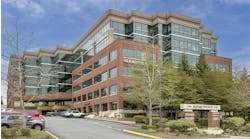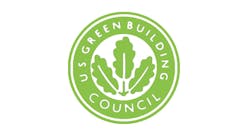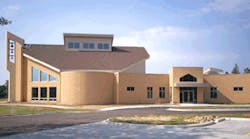MADISON, WIS. — The Benedictine Women of Madison work toward environmental solutions and teach the importance of nature in daily life as part of their mission, thus, it was natural that they aimed for a high level of sustainability when building their new monastery, which recently received U.S. Green Building Council LEED Platinum certification. The monastery earned 63 out of a possible 69 points under the LEED for New Construction Version 2.2 Rating System, making it the highest rated LEED Platinum building for new construction in the U.S.
Construction on the project started in spring 2008 and was completed August 2009. Holy Wisdom Monastery is a 34,380-sq.ft. two-level building structure with a detached, 4,000-sq.ft. remodeled maintenance building on 130 acres. The new building replaces the 60,000-sq.ft. Benedict House, which was responsibly deconstructed — 99.75% of the building was recycled or reused.
Sustainable features of the monastery include a geothermal heating and cooling system; photovoltaic cells on the monastery roof, which generates 13% of the building's energy needs (the goal is to eventually provide 100% of the monastery’s energy needs, on a net basis, from on-site renewable sources); a dedicated outdoor air delivery system with energy recovery that allows for natural ventilation; and low-flow toilets, faucets and waterless urinals. Other sustainable features include a white membrane roof, an accessible green roof on the garage and maintenance building, and windows with a customized glass to control glare and provide views, eliminating the need for window blinds.
The Sisters turned to Hoffman LLC, Appleton, Wis., to provide integrated project delivery with design and construction management. The firm has experience working on women’s religious community projects and sustainable projects. Hoffman utilized Vertegy, St. Louis, Mo., to provide additional support throughout the LEED certification process.
According to Mark Hanson, director of sustainable services, Hoffman LLC, the building is connected to the grid, and over the course of the year, the future goal when the photovoltaic system is expanded is to produce as much energy as is utilized in the building. There are times when the building will import energy from the grid and other times when the building will export energy to the grid.
“They want to be net-zero energy,” said Hanson. “Once the sisters reach that goal, their peak production of power will coincide with that time of the year when there are peak loads on the grid. So this is actually grid friendly since the monastery will produce the most power when the grid needs it the most. The monastery may be able to help the grid when the power system is being stressed. In a sense, the monastery is being community friendly by being connected to the grid.”
The monastery is also participating in Madison Gas and Electric’s Clean Power Partner Program in which the utility company buys up to 10kW of green power at a premium price and then sells it to customers who want to use renewable energy and reduce their environmental footprint. The monastery sells its solar power to Madison Gas and Electric for $0.25 per kWh.
Photovoltaic system
The 20 kW photovoltaic system is made up of 88 Sharp 224 solar panels located on the chapel roof, which faces southwest. Three Fronius inverters, which convert DC to AC power, are located in the utility room. The 10 kW inverter is for the power being sold directly to Madison Gas and Electric via the Clean Power Partner buyback program, and the two 5 kW inverters are for the power that the building is using or is being sent back into the utility transmission grid.
According to Burke O’Neal, co-owner and director of Full Spectrum Solar, Madison, Wis., the photovoltaic system took approximately 23 days to install with three people working on the installation.
“The people on this project were really great to work with, the sisters and all the subcontractors were very enthusiastic,” said O’Neal. “It was exciting to be involved in the overall project. Sometimes projects are done and solar is added at the end. This project was different. The Sisters and project team knew they were going to use solar, so we got a nice large area on the south facing roof to incorporate solar into the project.
“This was the initial photovoltaic system, and I think they plan to add more solar to the project down the line, added O’Neal. “This can be a good component for a fundraiser. There is an initial investment with solar, but it gives back and reduces a building’s operating costs too.”
“Adding more panels would get us [the monastery] up to zero-net energy,” said Hanson. “Once the original project is paid off and fundraising is done for additional PV, hopefully there will be more panels for the rest of the monastery roof and for the roof on the adjacent retreat house.”
According to Neal Smith, executive director at the monastery, it was estimated early on that energy use in the building is 60% below the LEED baseline building.
Mechanical systems
The HVAC system consists of a closed-loop geothermal system, designed by Sustainable Engineering Group LLC, Madison, Wis., made of up 39 wells, 300-ft. deep. It took approximately six weeks to install the system. In the winter the heat pumps move heat using a compressor cycle from the earth into the monastery, and in the summer heat in the building is pumped out and displaced in the earth. Radiant floor heat is used throughout the building.
There were a number of challenges when designing the geothermal system, according to Bert Fredericksen, vice president, Fredericksen Engineering Inc.
“The two that really pushed us were the owner’s desire for a very quiet environment in the building and the push to minimize energy usage,” said Fredericksen. “The sound issue was tackled by creating a separate thermal power plant that was isolated from the main building. This kept all of the compressors away from the main building.
“Typically we would have located multiple heat pumps throughout the building,” added Fredericksen. “In this case the need for a quiet environment pushed us to a central geothermal heat pump. We have taken this concept to more projects since Holy Wisdom Monastery.”
The building consists of four areas with separate ventilation systems: the chapel, the northwest area, the gathering and dining areas, and the kitchen and office areas.
According to Hanson, four ventilation systems are utilized because the Sisters wanted to be able to control the ventilation to meet the needs of particular areas. For example, the assembly room is just used for Sunday worship, concerts, special presentations, etc. Plus, there is a concert piano that is sensitive to humidity in the chapel, thus, it is necessary to keep the humidity range controlled in the chapel. However, the ventilation systems for the office, oratory, library, gathering and dining areas, are run much more often since these rooms are used more often.
Each ventilation system has energy recovery wheels, so air is being preheated or precooled depending on the time of year. The energy recovery wheels assist in the humidity control. All the larger rooms have carbon dioxide sensors to monitor air quality.
Water conservation
The sisters not only wanted their new monastery to conserve energy, they also wanted it to conserve water, thus water-conserving products were installed. Waterless urinals, 1-gpf single flush toilets, and low-flow faucets with automatic shut-off were installed in the building.
“We considered graywater, but it was not necessary for this building because water flows are so low,” explained Hanson. “They do use some rain barrels outside to catch rainwater, and there are two small green roofs.”
Also, 70% of the project’s site area was restored to native prairie habitat and storm water runoff has been reduced to 13% below pre-development levels, and the building water usage is 44% below a LEED baseline building because of the water conserving fixtures utilized.
“LEED certification is an affirmation that the monastery is fulfilling its mission and vision,” explained Smith. The Sister’s mission is to weave prayer, hospitality, justice and care for the earth into a shared way of life as an ecumenical Benedictine community.
“A second benefit of the certification is educational,” added Smith. “It provides the monastery the credentials to teach others that sustainable design and construction are possible at a reasonable cost.”
“This is a beautiful building that meets the sisters’ four mission requirements,” said Hanson. “This project shows how competitive the costs of this project are. The cost numbers are very good — $246 per sq. ft., including furnishings, all design and construction fees, and the deconstruction of Benedict House. One of the big hindrances of green building is the myth that green buildings must cost more. Some are expensive, but they don’t need to cost so much. However, it is up to the owner to decide what is really needed.”





